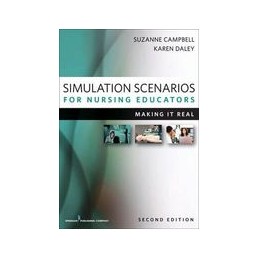- Obniżka

Zamawiaj do paczkomatu

Płać wygodnie


 Dostawa
Dostawa
Wybierz Paczkomat Inpost, Orlen Paczkę, DHL, DPD, Pocztę, email (dla ebooków). Kliknij po więcej
 Płatność
Płatność
Zapłać szybkim przelewem, kartą płatniczą lub za pobraniem. Kliknij po więcej szczegółów
 Zwroty
Zwroty
Jeżeli jesteś konsumentem możesz zwrócić towar w ciągu 14 dni*. Kliknij po więcej szczegółów
This second edition of an acclaimed book for nurse educators provides a practical, step-by-step guide to designing and developing simulation scenarios and integrating them into the nursing curriculum. Based on the findings of an extensive focus group that included contributing authors and new faculty, the text has been updated to include changes in simulation pedagogy since the first edition was published in 2008, and thoroughly reorganized to facilitate greater ease of use. An outstanding feature of the text is its provision of scenarios that are easily adaptable to the instructor's own lab. Additionally, these scenarios are ordered according to their complexity for quick access.
The authors provide concrete information about the use of simulation in a variety of programs, courses, and schools and include real life scenarios of how nursing faculty have mastered the challenge of integrating simulation into their curriculums. The book provides recommendations on integrating point of care decision-making tools, necessary equipment, how to set up a lab (including static to high fidelity mannequins), scenario running instructions, and much more. The text also includes an enhanced digital version guide. This updated edition includes::Opis
Preface
Part I - Setting the Foundation for Simulation
Chapter 1:: Introduction - Simulation focused pedagogy for nursing education
Chapter 2:: Integrating Simulation-focused Pedagogy into Curriculum
Chapter 3:: Enhancing Communication Skills through Simulations
Chapter 4:: Faculty Learning Communities:: An innovative Approach to Faculty Development
Chapter 5:: Building and Maintaining A Learning Resource Center
Part II - Innovative Simulation Scenarios in Diverse Settings for Diverse Students
Chapter 6:: Tune into Simulation through Physical Examination
Chapter 7:: Care of the Post-Surgical Appendectomy Patient in Pain
Chapter 8:: Medical Surgical Skill Based Scenarios
Chapter 8:: Trauma Resuscitation
Chapter 10:: Code Simulation for Student Nurses
Chapter 11:: Obstetric Emergency:: Post-partum Hemorrhage
Chapter 12:: Obstetric Labor and Delivery Emergency
Chapter 13:: Care of the Infant with Congenital Heart Disease Status Post Cardiac Surgical Repair
Chapter 14:: Non-Traumatic Head Injury - Infant
Chapter 15:: Bacterial Meningitis in a Pediatric Patient
Chapter 16:: Pediatric Emergency
Chapter 17:: Post-Traumatic Stress Disorder/Traumatic Brain Injury and other conditions in an Iraqi Veteran of War
Chapter 18:: Assessing a Patient with a Mood Disorder
Chapter 19:: Wound Management in Home Health Care
Chapter 20:: Diabetic Home Care Patient with Elevated Blood Sugars
Chapter 21 Home Care Scenario -Elevated Blood Sugar Emergency
Chapter 22:: Care of an Older Adult with Congestive Heart Failure
Chapter 23:: The Older Adult in an ICU with Acute Respiratory Failure
Chapter 24:: Communication with an Elderly Client
Chapter 25 - QSEN:: Knowledge, Skills and Values for Nurses
Chapter 26:: Innovative Simulation Scenarios in Diverse Settings for Diverse Students
Chapter 27 - Pediatric Palliative Care
Chapter 28:: OSCE for NP's
Chapter 29:: PsychMentalHealth
Chapter 30:: Women's Health NP/CNM
Chapter 32:: FNP - GI with Colon Cancer
Chapter 33:: Improving Patient Safety through Student Nurse-Resident Team Training:: The Central Venous Catheterization Pilot Project
Chapter 34:: Interdisciplinary Care of a Cardiac Infant
Chapter 35; Emergency Delivery - Shoulder Dystocia/Abruptio Placenta
Chapter 36:: Fire Safety in the OR
Chapter 37 Postpartum Hemorrhage
Chapter 38:: Undergraduate Senior Capstone Scenarios:: Pearls, Pitfalls and Politics
Chapter 39:: Student Generated Scenarios for Senior Simulation Day
Part III The Simulation Journey Continues
Chapter 40:: Cutting Edge Visions of the Future of Simulations
Chapter 41:: Framework for Simulation Learning in Nursing Education
Chapter 42:: Simulation Certification -
Chapter 43:: Publishing Your Simulation Research
Chapter 44:: Electronic health records
Chapter 45:: Faculty Development
Chapter 42:: Final Words of Wisdom on Simulation
